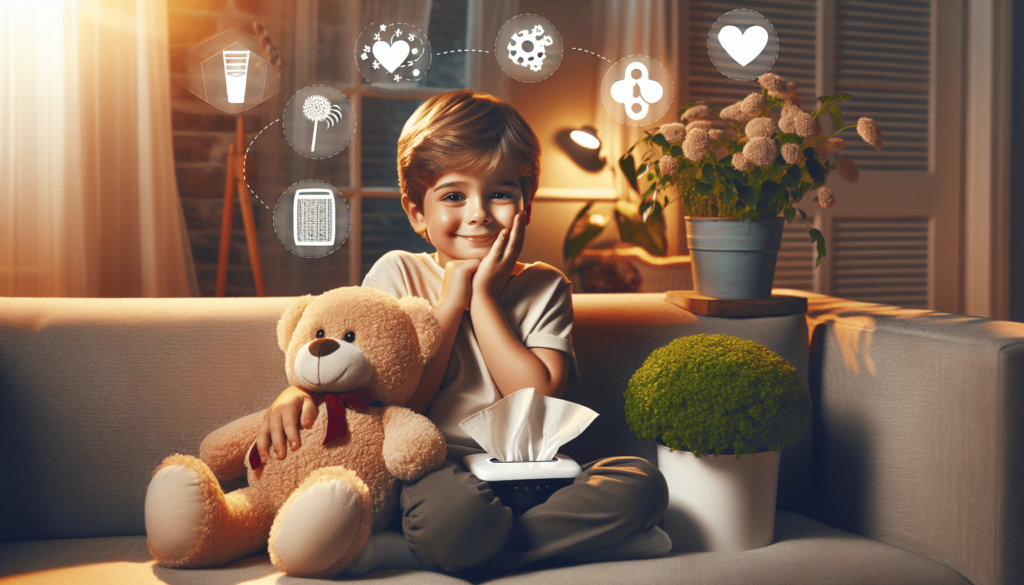Have you ever wondered how to best support your child when they’re suffering from allergies? You’re not alone. Managing allergies can be challenging, especially when it involves a child’s well-being. Allergies can range from mildly uncomfortable to severely debilitating, affecting your child’s everyday life and potentially altering family routines.
In this article, you’ll find tips, tricks, and helpful information for coping with child allergies. Knowing more about what your child is going through can help you make informed decisions about their health and comfort.

What Are Allergies?
Allergies occur when the immune system reacts to a foreign substance known as an allergen. This could include pollen, pet dander, certain foods, or medications. The body treats the allergen as a threat and tries to eliminate it, resulting in symptoms like sneezing, itching, or even more severe reactions.
Types of Allergies
Understanding the different types of allergies is crucial for managing your child’s symptoms effectively. Below are some common types of allergies found in children:
| Allergy Type | Common Allergens | Symptoms |
|---|---|---|
| Seasonal Allergies | Pollen from trees, grass, and weeds | Sneezing, itching, runny nose, watery eyes |
| Food Allergies | Nuts, dairy, eggs, shellfish | Hives, stomach cramps, vomiting, anaphylaxis |
| Animal Allergies | Pet dander, saliva, urine | Wheezing, coughing, itchy eyes, skin rash |
| Dust Allergies | Dust mites, dead skin | Sneezing, runny nose, asthma flare-ups |
| Insect Allergies | Bee stings, wasp stings | Swelling, pain, anaphylaxis |
| Medication Allergies | Penicillin, aspirin, ibuprofen | Rash, itchy skin, breathing difficulties, anaphylaxis |
Identifying Allergy Symptoms
Recognizing the symptoms is the first step in helping your child manage allergies. Symptoms can vary in severity and may sometimes be mistaken for other conditions like colds or the flu.
Common Symptoms
Some symptoms to be aware of include:
- Respiratory Symptoms: Sneezing, coughing, wheezing, itchy or runny nose.
- Skin Reactions: Rashes, hives, eczema, swelling.
- Gastrointestinal Issues: Nausea, vomiting, diarrhea, stomach cramps.
- General Symptoms: Fatigue, irritability, headaches, and difficulty concentrating.
When to See a Doctor
If your child’s symptoms are severe or persistent, it may be time to consult with a healthcare provider. Symptoms that warrant immediate medical attention include difficulty breathing, sudden swelling of the face or lips, and anaphylaxis.
Diagnosing Allergies
Proper diagnosis is crucial for effective management. There are several methods doctors use to diagnose allergies in children.
Skin Prick Test
In this test, small amounts of allergens are introduced into the skin, usually on the arm or back. If a raised bump appears, it indicates an allergic reaction.
Blood Tests
Blood tests, like the ImmunoCAP test, measure the amount of certain antibodies in the blood, providing clues about allergy triggers.
Elimination Diet
For food allergies, your doctor may suggest an elimination diet, where suspected allergens are removed from the diet and then gradually reintroduced to identify triggers.
Common Allergy Triggers
Knowing what triggers your child’s allergies can help you avoid or minimize exposure. This section elaborates on some typical allergens and where they are commonly found.
Pollen
Pollen is a common trigger, especially in spring and fall. Major culprits include tree pollen in the spring and weed pollen in the fall.
Dust Mites
Dust mites thrive in warm, humid environments. They are often found in bedding, upholstered furniture, and carpets.
Pet Dander
Pet dander consists of tiny flakes of skin shed by animals. Cats and dogs are common sources, but any furry animal can contribute.
Certain Foods
Common food allergens include peanuts, tree nuts, milk, eggs, wheat, soy, fish, and shellfish. Always read food labels carefully.
Insect Stings
Bees, wasps, and ants are typical insect stings that can cause allergic reactions. Carrying an epinephrine auto-injector is advisable if your child has a known insect allergy.

Managing Allergies
Managing your child’s allergies involves a combination of avoiding triggers, medication, and lifestyle adjustments. Here’s how you can handle each approach effectively.
Avoiding Triggers
The best way to manage allergies is to avoid the allergen. This might involve:
- Keeping windows closed during high pollen seasons
- Using air purifiers and dehumidifiers
- Regularly washing bedding in hot water
- Keeping pets out of your child’s bedroom
Medication
Various medications can alleviate allergy symptoms. Commonly prescribed options are:
- Antihistamines: These reduce symptoms like sneezing, itching, and runny nose.
- Decongestants: Help to relieve nasal congestion but should not be used for extended periods.
- Nasal Corticosteroids: Reduce inflammation in the nasal passages and are effective for long-term management.
- Epinephrine: Used for severe allergic reactions (anaphylaxis) and should be carried at all times if prescribed by a doctor.
Natural Remedies
For those looking for alternative approaches, natural remedies may offer some relief. However, consult your healthcare provider before starting any new treatment.
- Saline Nasal Rinses: Can help clear nasal passages.
- Butterbur: A herbal supplement that has shown some promise in treating allergies.
- Quercetin: A flavonoid believed to have anti-inflammatory properties.
Creating Allergy-Friendly Environments
Creating an allergy-friendly environment at home and school can hugely benefit your child. Here are some tips to help you make these spaces safer.
Home Environment
- Bedroom: Use hypoallergenic mattress and pillow covers. Keep the room clean and free from clutter.
- Living Areas: Vacuum with a HEPA filter. Use washable rugs and keep windows closed during pollen season.
- Kitchen: Store food securely and clean up spills immediately to prevent pests that could trigger allergies.
School Environment
Communicate with your child’s school to ensure they understand your child’s needs. Provide the school with an action plan in case of an allergic reaction. Ensure your child has access to necessary medications and knows how and when to use them.

Emotional and Social Challenges
Dealing with allergies can be emotionally and socially challenging for children. Feeling different from peers or missing out on activities can be tough. Here’s how you can offer support beyond the physical symptoms.
Encourage Open Communication
Encourage your child to talk about how they feel. Understanding their emotional struggles can help you offer the support they need.
Educate and Empower
Teach your child about their allergies and how to manage them. Empowering them to take charge of their condition can build confidence and reduce anxiety.
Support Groups
Consider joining allergy support groups where your child can meet others facing similar challenges. This can provide a sense of community and shared understanding.
Preparing for Emergencies
Despite your best efforts, emergencies can happen. Being prepared can make a significant difference in how you handle these situations.
Emergency Action Plan
Work with your healthcare provider to create an emergency action plan. This should include:
- Contact information for healthcare providers and emergency services
- List of all known allergens
- Steps to take in case of exposure
- Instructions on using emergency medications, such as an epinephrine auto-injector
Medical IDs
Consider having your child wear a medical ID bracelet or necklace that lists their allergies and essential information. This can be crucial in emergencies when every second counts.
Practice Drills
Regularly practice your emergency action plan with your child and other family members. Being prepared can ease anxiety and ensure everyone knows what to do.

The Role of Diet and Nutrition
Diet and nutrition play an essential role in managing allergies. Certain foods can exacerbate symptoms, while others can help mitigate them.
Foods to Avoid
If your child has food allergies, careful attention must be paid to their diet. Common allergenic foods include:
- Dairy
- Eggs
- Peanuts and tree nuts
- Shellfish
- Soy
Foods That May Help
Some foods have natural anti-inflammatory properties and could help reduce allergy symptoms. These include:
- Fatty fish rich in omega-3 fatty acids (like salmon)
- Fruits and vegetables high in antioxidants (like berries and leafy greens)
- Foods rich in Vitamin C (like oranges and strawberries)
Reading Labels
Learning to read food labels is crucial if your child has food allergies. Be vigilant about ingredient lists and look out for hidden allergens.
The Future of Allergy Management
Advancements in science and medicine are continuously improving the way we manage allergies. Staying informed about new treatments and approaches can help you provide the best care for your child.
Immunotherapy
Immunotherapy involves gradually exposing the body to increasing amounts of an allergen to build tolerance over time. This can be done through:
- Allergy Shots: Regular injections over a period of time.
- Oral Immunotherapy: Consuming small amounts of the allergen under medical supervision.
- Sublingual Tablets: Allergen tablets placed under the tongue.
Biologics
Newer medications called biologics are being used to treat severe cases of allergies and asthma. These target specific pathways in the immune system and can reduce the frequency and severity of symptoms.
Research and Development
Ongoing research is continually uncovering new ways to treat and manage allergies. Staying updated through reputable medical journals and trusted sources can help you stay ahead of new developments.
Coping Strategies for Parents
As a parent, dealing with your child’s allergies can be stressful. Here are some strategies to help you cope.
Stay Informed
Educate yourself about your child’s allergies. Knowledge is power and can help you make informed decisions.
Take Care of Yourself
Don’t forget to look after your own well-being. Managing a child’s allergies can be demanding, so make sure you also get the support and rest you need.
Build a Support Network
Connect with other parents facing similar challenges. Sharing experiences and tips can provide mutual support and valuable insights.
Conclusion
Helping your child cope with allergies is a journey that involves understanding, patience, and proactive management. By being informed and prepared, you can make a significant difference in your child’s quality of life. Remember, you’re not alone in this; plenty of resources and communities are available to support you and your family. With the right strategies, you and your child can navigate the challenges of allergies effectively and confidently.
